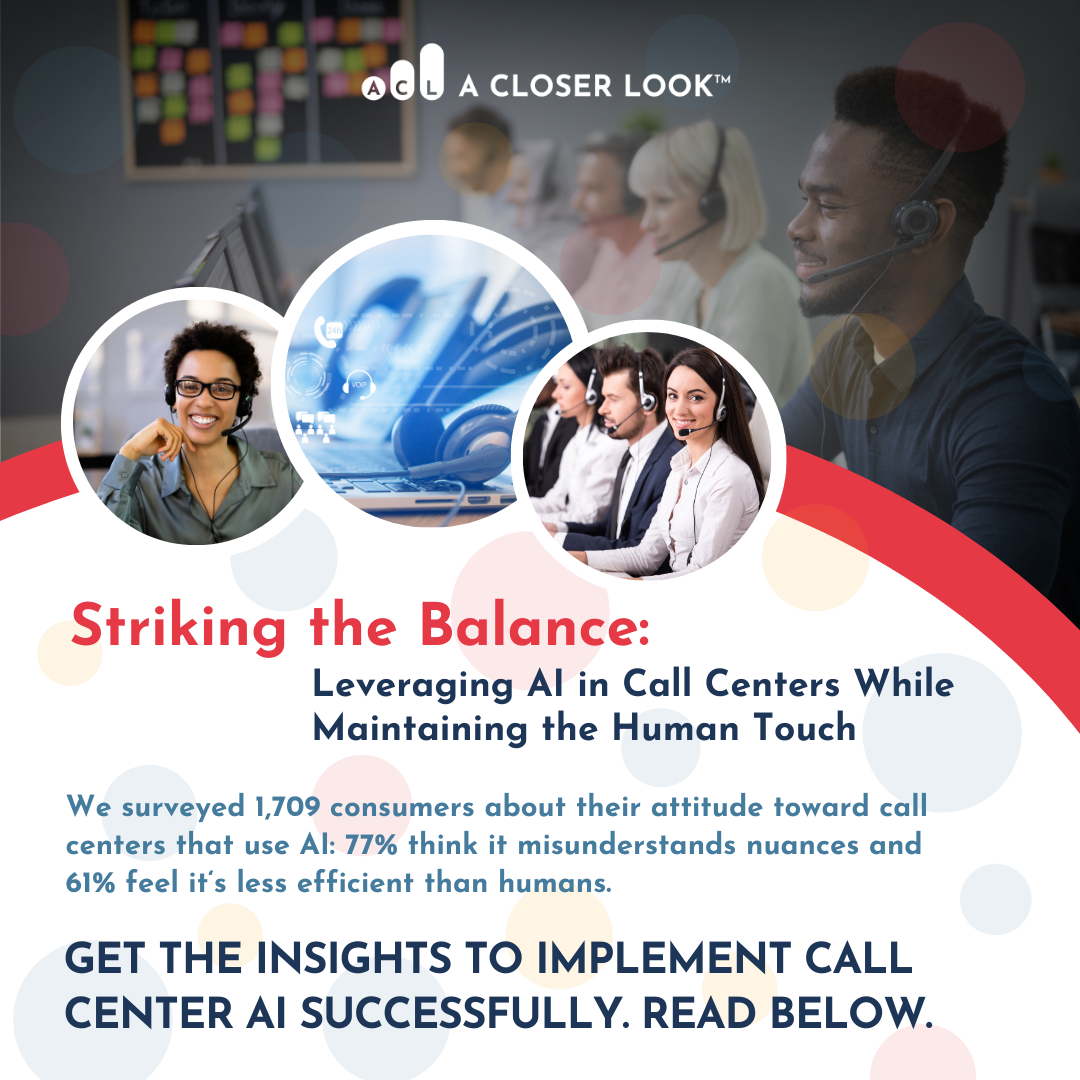
Striking the Balance: Leveraging AI in Call Centers While Maintaining the Human Touch
Executive Summary
A Closer Look conducted a survey of 1,709 consumers to understand their perceptions, attitudes, and experiences with artificial intelligence (AI) in customer service.
The study reveals that while customers recognize the potential efficiency benefits of AI, they still strongly value human interaction for its empathy, personalization, and ability to handle complex issues.
The key to successful AI implementation in call centers lies in striking the right balance between leveraging AI’s strengths and preserving the human touch. By strategically integrating AI and human interaction, call centers can enhance the customer experience, improve operational efficiency, and build long-term brand loyalty.
Key Insights
- 50% of respondents have a more negative opinion of companies that use AI instead of humans for customer service, highlighting the importance of balancing AI efficiency with human interaction to maintain positive brand perception.
- 61% of respondents believe AI customer service interactions are less efficient than those with human representatives, indicating a need for improved AI systems that can better understand and resolve customer issues.
- 77% of respondents think AI does not understand the nuances of their requests as well as human representatives, emphasizing the importance of investing in advanced AI technologies to handle complex, context-dependent inquiries.
- 45% of respondents are not satisfied with the resolutions provided by AI customer service interactions, underscoring the need for AI systems that can deliver more accurate, personalized, and effective solutions.
- Respondents strongly prefer human representatives for web chats and SMS/text messages but are more comfortable with AI for social media messaging and phone calls, suggesting that call centers should focus AI implementation on channels where customers are more receptive.
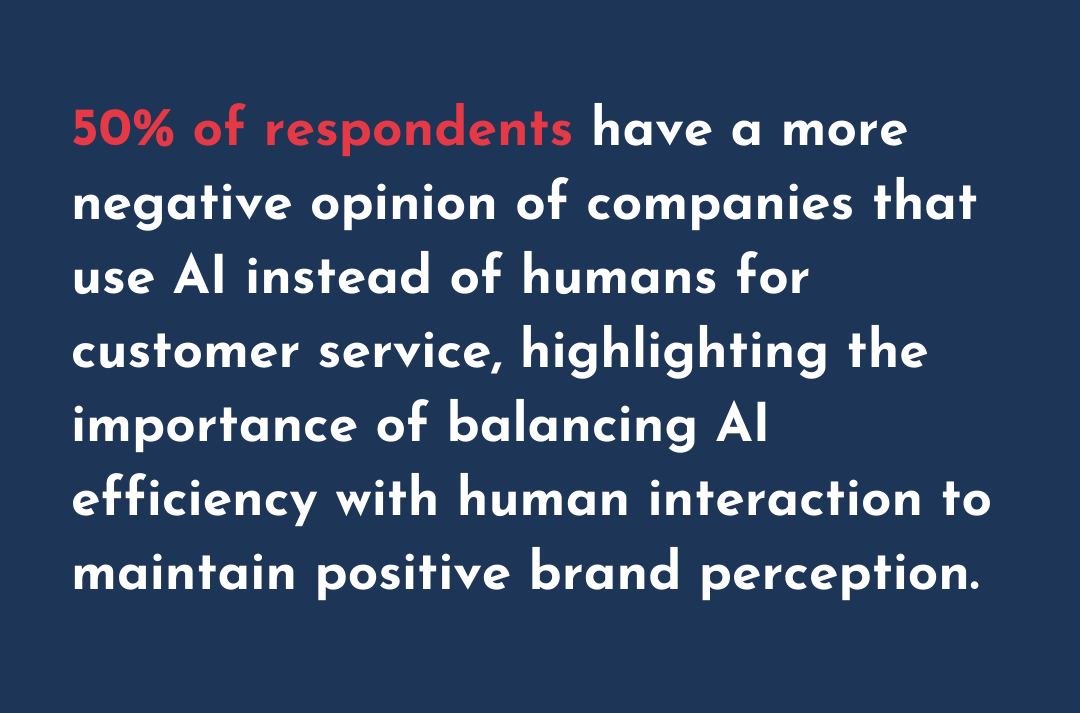
Research Methodology
A Closer Look conducted an online survey of 1,709 consumers from its first-party database. The survey consisted of multiple-choice and open-ended questions designed to gauge respondents’ perceptions, attitudes, and experiences with AI in customer service. The data was collected, analyzed, and synthesized to identify key insights and trends.
Top Themes from Open-Ended Comments
- Preference for human interaction “Nothing can replace human interaction.” Many respondents emphasized their strong preference for interacting with human representatives, feeling that AI lacks the empathy, emotional intelligence and ability to handle complex issues that humans provide.
- AI as a complementary tool, not a replacement “AI is a great resource for you, however nothing will change a human prefrontal cortex in complex decision making.” While seeing value in AI handling basic, repetitive queries, most still want the option to quickly and seamlessly transfer to a human agent when needed. AI is seen as a complementary tool to improve efficiency, not a full replacement for human interaction.

- Frustration with AI’s limitations “I have been caught in loops where the AI chat thing doesn’t understand my question and I simply cannot make any progress. So frustrating. I want to scream.” Many expressed frustration with AI’s inability to understand context, nuance, and anything beyond simple queries. Getting stuck in unproductive loops and being unable to progress to a human agent causes significant dissatisfaction.
- Job loss concerns “AI replaces humans meaning someone is out of a job and potential income!” Respondents worry about AI displacing human jobs, especially in economically challenging times. Some prefer to support companies that continue providing employment to people.
- Cautious optimism about AI’s future “I think as AI involves it can potentially be a better tool for some companies because it may significantly reduce wait times. We will all have to adapt fairly soon to this change.” While many have reservations about current AI capabilities, some expressed optimism that the technology will improve over time to provide better customer service. However, seamless escalation to human agents when needed remains critical.
Introduction
As artificial intelligence (AI) continues to advance and permeate various industries, its role in customer service has become increasingly prominent. Call centers, in particular, are turning to AI to streamline operations, reduce costs, and provide 24/7 assistance to customers. However, the implementation of AI in customer service is not without its challenges and pitfalls.
The AI Advantage: Efficiency and 24/7 Availability
One of the primary benefits of AI in customer service is its ability to handle a large volume of inquiries simultaneously, at any time of day. The survey found that 67% of respondents have engaged with an AI chat tool in the past year, while 24% have not engaged, and 9% are unsure if they have engaged. This data indicates widespread adoption of AI in customer service, but also suggests that there is still a significant portion of customers who have not interacted with AI or are unaware of their engagement.

AI-powered chatbots and virtual assistants can quickly provide answers to common questions, freeing up human agents to tackle more complex issues. However, efficiency alone does not guarantee customer satisfaction. The survey revealed that 61% of respondents believe AI customer service interactions are less efficient than those with human representatives, while 28% were neutral, and only 11% feel AI is more efficient. This perception gap suggests that the current state of AI in customer service still has room for improvement in terms of understanding customer needs and providing swift, accurate resolutions.
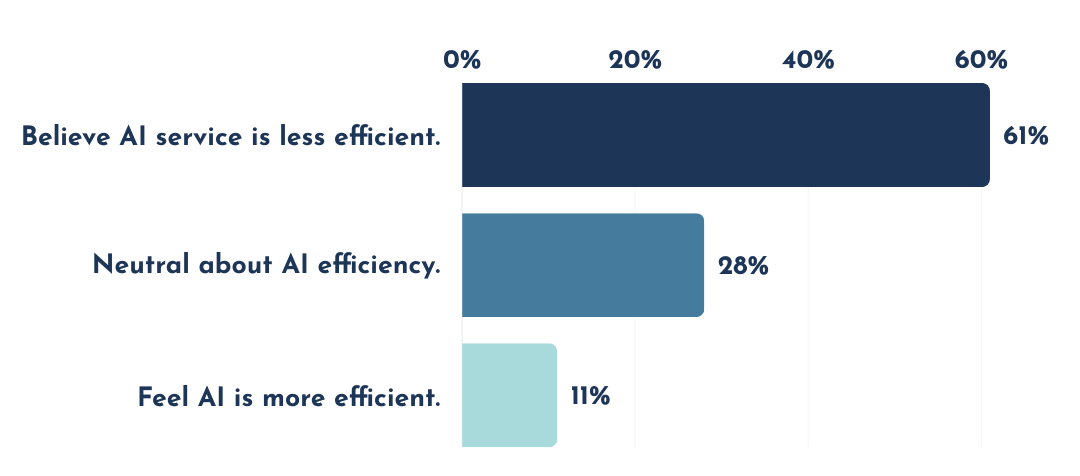
Impact on Company Perception
The use of AI in customer service can also impact customers’ opinions of companies. The survey found that 50% of respondents have a more negative opinion of a company when they use AI versus humans to handle an inquiry or issue. However, 41% state that it does not change their opinion, and 9% view the company more positively.
This data highlights the importance of implementing AI in a way that complements, rather than replaces, human interaction. Companies must strike a balance between leveraging AI’s efficiency and maintaining the human touch to avoid negative impacts on brand perception.

The Human Touch: Empathy, Personalization, and Trust
The survey results underscore the enduring value of human interaction in customer service. When given the choice, 86% of respondents prefer to interact with a human representative. This preference stems from several key factors:
- Empathy and Emotional Understanding: 87% of respondents perceive a lack of empathy or emotional understanding from AI in customer service interactions. Customers want to feel heard, understood, and valued, which AI struggles to replicate.
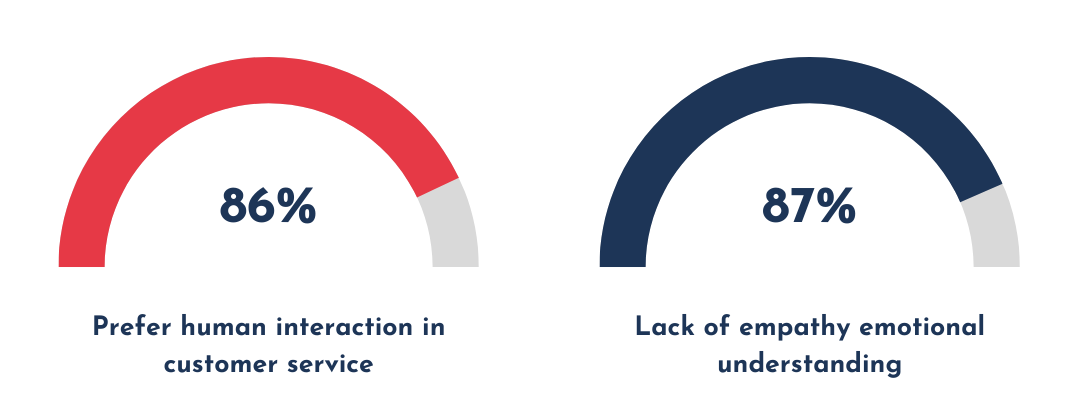
- Personalization: 60% of respondents do not find AI customer service to be personalized, while only 16% do, and 24% were neutral. Human agents have the ability to tailor their approach to each individual customer, taking into account their unique circumstances and needs.
- Trust and Sensitive Information: When asked about their trust in AI to handle sensitive information during customer service interactions, 51% of respondents expressed distrust (29% somewhat distrust and 23% distrust completely). Only 24% of respondents trust AI with sensitive information (6% trust completely and 18% trust somewhat), while 25% remained neutral. Building trust is crucial in customer service, and many customers feel more comfortable sharing personal details with a human representative.

Comfort Levels with AI Interactions
Another aspect investigated by the survey was respondents’ comfort levels when they realize they are interacting with AI for customer service. The results show that 47% of respondents are somewhat or very uncomfortable (32% somewhat uncomfortable and 15% very uncomfortable), while 29% are neutral, and only 24% are comfortable or very comfortable (16% somewhat comfortable and 8% very comfortable).
This data suggests that a significant portion of customers are not yet fully at ease with AI-driven customer service interactions. Companies must work to improve the design and implementation of AI systems to create more natural, intuitive, and comfortable experiences for users.

The Frustration Factor: Navigating AI Limitations
A common theme that emerges from the open-ended comments is the frustration customers experience when AI fails to understand their needs or provide satisfactory resolutions. Getting trapped in unproductive loops, repeating information, and struggling to reach a human agent can quickly erode customer goodwill and brand loyalty.
The survey found that 62% of respondents feel their expectations of the customer service experience change when interacting with AI-driven tools compared to human representatives. When asked how their expectations changed, several common themes emerged:
- Lack of understanding and nuance: Many respondents feel that AI will not be able to fully comprehend their issue, especially if it is complex or unique. They expect AI to provide generic, scripted responses that may not address the specific problem at hand.
- Increased frustration and wasted time: People anticipate having to repeat themselves multiple times, rephrase their questions, or go through a series of unhelpful prompts before potentially being transferred to a human representative. This leads to frustration and a feeling that their time is being wasted.
- Lower expectations for problem resolution: When interacting with AI, many individuals expect that their issue will not be resolved satisfactorily. They believe that AI has limitations in its ability to provide tailored solutions, and they may need to escalate the issue to a human representative to achieve a resolution.
- Lack of empathy and human connection: Respondents feel that AI lacks the empathy, emotional understanding, and personal touch that a human representative can provide. They expect the interaction to feel less genuine and more mechanical, which can lead to a less satisfying customer service experience overall.
These changing expectations highlight the importance of designing AI systems that can better understand and address customers’ unique needs, while also providing a seamless transition to human representatives when necessary.
Understanding Nuance: AI vs. Human Representatives
To further understand the differences between AI and human representatives, the survey examined respondents’ perceptions of AI’s ability to understand the nuances of their requests compared to human representatives. The results show that 77% of respondents think AI does not understand the nuances of their requests as well as human representatives (47% feel AI is somewhat worse and 30% feel AI is much worse). Only 15% feel AI is about the same as humans when dealing with nuanced requests, and a mere 8% feel AI better understands the request than humans (6% somewhat better and 2% much better).
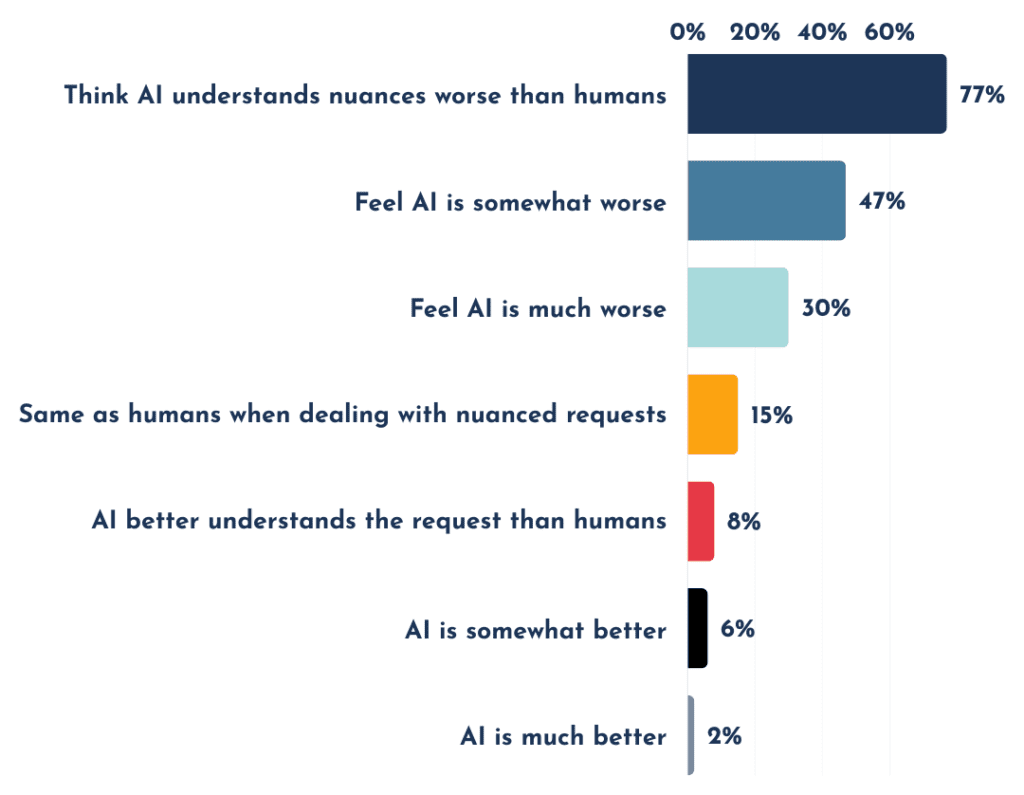
This data underscores the need for companies to invest in advanced AI technologies, such as natural language processing and machine learning, to improve AI’s ability to understand and respond to complex, nuanced customer inquiries. By continuously refining AI algorithms and training them on diverse datasets, companies can work towards closing the gap between AI and human representatives in handling nuanced requests.
Satisfaction with AI-Provided Resolutions
Customer satisfaction with AI-provided resolutions was another key area assessed by the survey. The results show that 45% of respondents are not satisfied (28% somewhat dissatisfied and 17% very dissatisfied), while 28% are neither satisfied nor dissatisfied, and only 27% are satisfied (23% somewhat satisfied and 4% very satisfied).
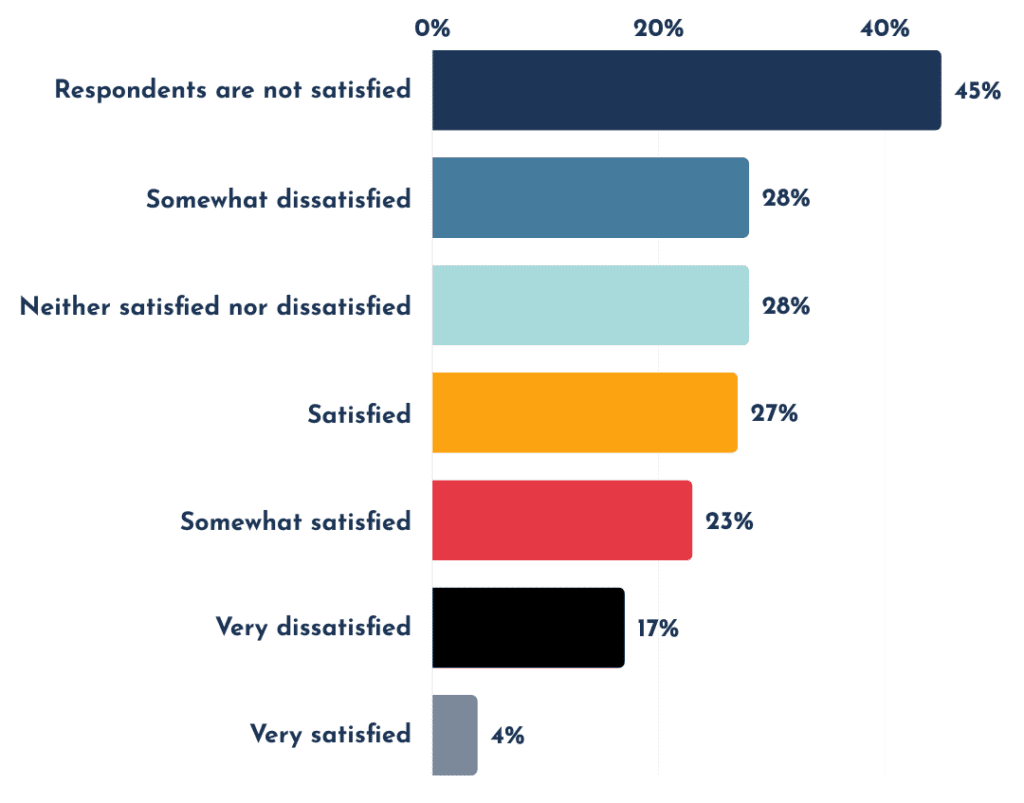
This data underscores the need for call centers to invest in AI systems that can provide more accurate, personalized, and effective resolutions to customer inquiries. By continuously training and improving AI algorithms, companies can work towards increasing customer satisfaction with AI-driven interactions.
Channel Preferences: AI vs. Human Interaction
The survey delved into respondents’ preferences for interacting with AI or human representatives across different customer service channels. Respondents were asked to rank the following channels from 1 to 5, with 1 being where they would be most comfortable interacting with AI and 5 being where they would strongly prefer a human representative:
1. Email: Respondents were relatively evenly split, with 22% ranking email as a 1 (most comfortable with AI), 26% as a 2, 25% as a 3, 24% as a 4, and only 4% as a 5 (strongly preferring a human representative).
2. Web chat: 36% of respondents ranked web chat as a 1 (most comfortable with AI), while only 5% ranked it as a 5 (strongly preferring a human representative). This suggests that customers are more open to AI-driven web chat compared to other channels.
3. SMS/Text message: Respondents were more evenly distributed, with 16% ranking SMS/text as a 1 (most comfortable with AI), 33% as a 2, 32% as a 3, 17% as a 4, and only 3% as a 5 (strongly preferring a human representative).
4. Social media: 15% of respondents ranked social media as a 1 (most comfortable with AI), 14% as a 2, 19% as a 3, 30% as a 4, and 21% as a 5 (strongly preferring a human representative). This indicates a stronger preference for human interaction on social media compared to other channels.
5. Phone call: A significant majority (67%) of respondents ranked phone calls as a 5 (strongly preferring a human representative), while only 12% ranked it as a 1 (most comfortable with AI). This highlights the importance of maintaining human agents for phone-based customer service.
These channel preferences suggest that call centers should focus AI implementation on channels where customers are more receptive, such as web chat and SMS/text, while ensuring that human representatives are readily available for phone calls and social media interactions.
Feedback and Sentiment: Room for Improvement
The survey revealed that 64% of respondents have rarely or never been asked to provide feedback on their experience after an AI customer service interaction, while only 36% have been asked for feedback always or sometimes. This lack of feedback collection represents a missed opportunity for call centers to gather valuable insights and continuously improve their AI systems based on customer input.
Furthermore, the survey found that 61% of respondents feel somewhat or very negative about the increasing role of AI in customer service, while 21% are neutral, and only 18% feel somewhat or very positive. This sentiment underscores the importance of implementing AI in a way that enhances, rather than detracts from, the customer experience.
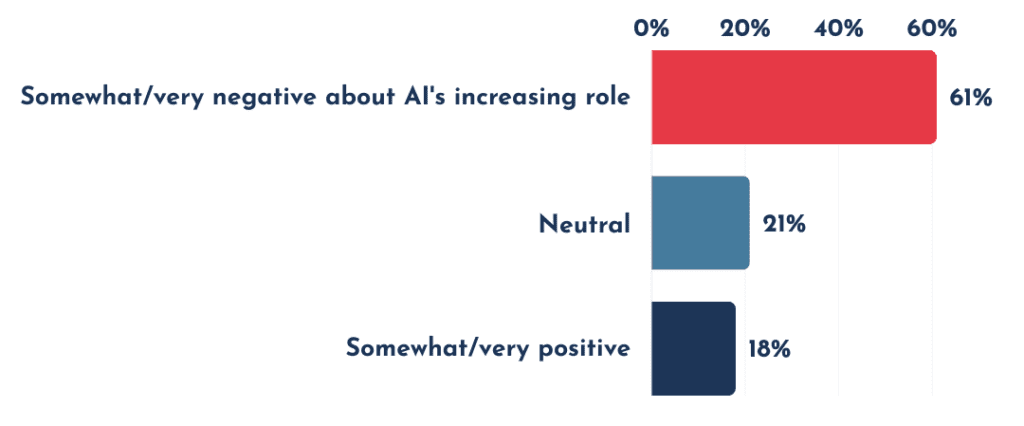
The Path Forward: Striking the Balance
As AI technology continues to evolve, its role in customer service will undoubtedly grow. However, the survey results make it clear that AI should not be seen as a wholesale replacement for human interaction. Instead, call centers must strike a delicate balance, leveraging AI’s efficiency while preserving the empathy and personalization that customers value.
Some best practices for integrating AI and human interaction include:
1. Strategic Channel Allocation: Focus AI implementation on channels where customers are more receptive, such as web chat and SMS/text, while maintaining human representatives for phone calls and social media interactions.
2. Seamless Escalation: Ensure that AI systems can quickly identify when a customer needs human assistance and seamlessly transfer them without the need for repetition.
3. Feedback Collection: Regularly seek customer feedback on AI interactions to gather insights and continuously improve the system’s performance and user experience.
4. Transparency and Choice: Be transparent about when customers are interacting with AI and provide them with the choice to easily transfer to a human representative when needed.
5. AI Training and Optimization: Invest in advanced AI systems that can better understand context, nuance, and complex queries to minimize customer frustration and improve resolution rates.
6. Human Agent Empowerment: Equip human agents with the skills, knowledge, and resources to handle escalations from AI interactions effectively and empathetically.
By strategically integrating AI and human interaction, call centers can enhance the customer experience, improve operational efficiency, and build long-term brand loyalty. The key lies in understanding and adapting to customer preferences, investing in advanced AI systems, and empowering human agents to provide the empathetic support that AI cannot replicate.
As the customer service landscape continues to evolve, organizations that can successfully navigate the AI tightrope – balancing efficiency and empathy – will be well-positioned to thrive in an increasingly competitive and customer-centric world.
Conclusion
The findings presented in this report provide valuable insights for call center operators seeking to strike the right balance between leveraging AI and maintaining the human touch in their customer service operations. The survey results underscore the importance of strategically integrating AI and human interaction to enhance the customer experience, improve operational efficiency, and build long-term brand loyalty.
To achieve this balance, call centers should focus on implementing AI in channels where customers are more receptive, such as web chat and SMS/text, while ensuring that human representatives are readily available for phone calls and social media interactions. Investing in advanced AI technologies that can better understand context, nuance, and complex queries will be crucial in minimizing customer frustration and improving resolution rates.
Furthermore, call centers must prioritize transparency and choice, clearly communicating when customers are interacting with AI and providing them with the option to easily transfer to a human representative when needed. Regularly seeking customer feedback on AI interactions will help gather valuable insights and continuously improve the system’s performance and user experience.
As AI technology continues to evolve, it is essential for call centers to stay informed about customer preferences and adapt their strategies accordingly. By empowering human agents with the skills, knowledge, and resources to handle escalations from AI interactions effectively and empathetically, call centers can create a seamless and satisfying customer service experience that maintains the human touch.
Striking the balance between AI and human interaction in customer service is a complex challenge, but with the right approach and a commitment to leveraging AI while preserving empathy and personalization, call centers can position themselves for success in an increasingly competitive and customer-centric world.
For companies looking to gain a deeper understanding of their customers’ sentiments regarding AI in customer service or to benchmark their performance against industry trends, A Closer Look offers tailored first-party market research solutions. By leveraging our expertise and robust methodology, businesses can access valuable insights to inform their AI implementation strategies and stay ahead of the curve in delivering exceptional customer experiences that strike the perfect balance between technology and the human touch.
Learn more about conducting Focused Feedback Surveys with A Closer Look’s first-party consumer database, or with your own brand’s customers, to gain insights about consumer behaviors and trends.
Contact A Closer Look today to learn more about how we can help you navigate the complexities of AI integration and thrive in the evolving customer service landscape.